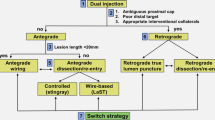Abstract
Chronic Total Occlusion (CTO) remains the most challenging lesion to treat using Percutaneous Coronary Intervention (PCI). Multiple strategies exist to facilitate lesion crossing and subsequent stenting of the target vessel. The antegrade dissection and re-entry (ADR) technique was developed to provide another option for patients to facilitate a successful CTO PCI procedure. This chapter provides a step-by-step approach to learn the technique.
Access this chapter
Tax calculation will be finalised at checkout
Purchases are for personal use only
Similar content being viewed by others
References
Morino Y, Kimura T, Hayashi Y, et al. In-hospital outcomes of contemporary percutaneous coronary intervention in patients with chronic total occlusion. Insights from the J-CTO registry (multicenter CTO registry in Japan). JACC Cardiovasc Interv. 2010;3:143–51.
Tsujita K, Maehara A, Mintz GS, et al. Intravascular ultrasound comparison of the retrograde versus antegrade approach to percutaneous intervention for chronic total coronary occlusions. JACC Cardiovasc Interv. 2009;2:846–54.
Muhammad KI, Lombardi WL, Christofferson R, Whitlow PL. Subintimal guidewire tracking during successful percutaneous therapy for chronic coronary total occlusions: insights from an intravascular ultrasound analysis. Catheter Cardiovasc Interv. 2012;79:43–8.
Daniels D. Hybrid video registry – presented TCT. 2013.
Tsuchikane E, Yamane M, Mutoh M, et al. Japanese multicenter registry evaluating the retrograde approach for chronic coronary total occlusion. Catheter Cardiovasc Interv. 2013;82:E654–61.
Whitlow PL, Burke N, Lombardi WL, et al. Use of a novel crossing and re-entry system in coronary chronic total occlusions that have failed standard crossing techniques. JACC Cardiovasc Interv. 2012;5:393–401.
Colombo A, Mikhail GW, Michev I, et al. Treating chronic total occlusions using subintimal tracking and reentry: the STAR technique. Catheter Cardiovasc Interv. 2005;64:407–11.
Carlino M, Godino C, Latib A, Moses JW, Colombo A. Sub-intimal tracking and re-entry technique with contrast guidance: a safer approach. Catheter Cardiovasc Interv. 2008;72:790–6.
Godino C, Latib A, Economou FI, et al. Chronic total occlusions: mid-term comparison of clinical outcome following the use of the guided-STAR technique and conventional anterograde approaches. Catheter Cardiovasc Interv. 2012;79:20–7.
Valenti R, Vegara R, Migliorini A, et al. Predictors of reocclusion after successful drug-eluting stent–supported percutaneous coronary intervention of chronic total occlusion. J Am Coll Cardiol. 2013;61:545–50.
Rinfret S, Ribeiro HB, Nguyen CM, et al. Dissection and re-entry techniques and longer-term outcomes following successful percutaneous coronary intervention of chronic total occlusion. Am J Cardiol. 2014;114:1354–60.
Fairley SL, Spratt JC, Rana O, et al. Adjunctive strategies in the management of resistant, ‘undilatable’ coronary lesions after successfully crossing a CTO with a guidewire. Curr Cardiol Rev. 2014;10:145–57.
Author information
Authors and Affiliations
Corresponding author
Editor information
Editors and Affiliations
Electronic supplementary material
Below is the link to the electronic supplementary material.
Video 6.1
Classical ADR with a stick and drive technique: More than 20 mm RCA CTO without ambiguity of the proximal cap. (AVI 3179 kb)
Video 6.2
Classical ADR with a stick and drive technique: CrossBoss into vessel structure, into the sub-intimal space at the distal cap. (AVI 3320 kb)
Video 6.3
Classical ADR with a stick and drive technique: Re-entry will have to be performed through the port pointing inferiorly. (AVI 2420 kb)
Video 6.4
Classical ADR with a stick and drive technique: Re-entry with the StingRay wire into the distal true lumen, as confirmed with a retrograde injection. (AVI 15131 kb)
Video 6.5
Classical ADR with a stick and drive technique: Final result post stenting. (AVI 2201 kb)
Video 6.6
ADR with a ‘Stick and Swap’ technique: 20 mm CTO with a non-ambiguous cap, and a good distal landing zone. (AVI 3220 kb)
Video 6.7
ADR with a ‘Stick and Swap’ technique: Sub-intimal tracking with Pilot 200 guidewire. (AVI 3960 kb)
Video 6.8
ADR with a ‘Stick and Swap’ technique: CrossBoss to distal cap. (AVI 12779 kb)
Video 6.9
ADR with a ‘Stick and Swap’ technique: StingRay in place: Stick with StingRay wire. (AVI 26344 kb)
Video 6.10
ADR with a ‘Stick and Swap’ technique: Swap with Pilot 200 into distal true lumen, as confirmed with retrograde injection. (AVI 5159 kb)
Video 6.11
ADR with a ‘Stick and Swap’ technique: Final result after stenting. (AVI 2508 kb)
Rights and permissions
Copyright information
© 2016 Springer International Publishing Switzerland
About this chapter
Cite this chapter
Walsh, S. (2016). When and How to Perform an Antegrade Dissection/Re-entry Approach using the CrossBoss and Stingray Catheters. In: Rinfret, S. (eds) Percutaneous Intervention for Coronary Chronic Total Occlusion. Springer, Cham. https://doi.org/10.1007/978-3-319-21563-1_6
Download citation
DOI: https://doi.org/10.1007/978-3-319-21563-1_6
Publisher Name: Springer, Cham
Print ISBN: 978-3-319-21562-4
Online ISBN: 978-3-319-21563-1
eBook Packages: MedicineMedicine (R0)




